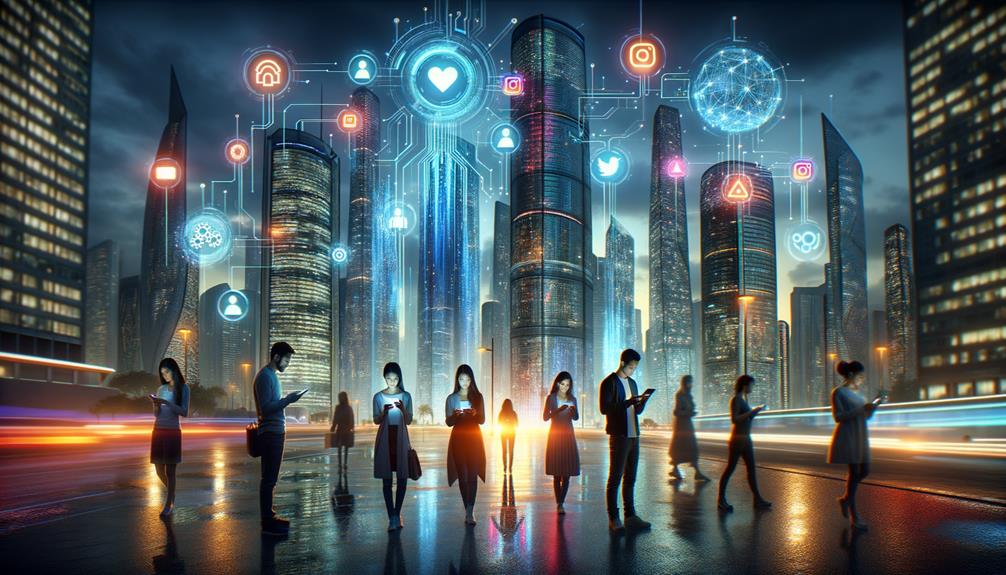

Vous êtes à l'aube d'une révolution dans les médias sociaux. 2024 devrait apporter des avancées sans précédent dans les domaines suivants Création de contenu pilotée par l'IA, domination vidéoet commerce social qui redéfinira la façon dont vous interagissez avec votre public. Vous devrez vous adapter à l'évolution des comportements des utilisateurs, tirer parti des outils d'intelligence artificielle pour personnaliser le contenu et maîtriser l'utilisation de la technologie de l'information. stratégies vidéo de courte durée pour stimuler l'engagement. Avec les tendances émergentes telles que le commerce social et le référencement, vous devrez également donner la priorité à l'authenticité et à la transparence dans vos activités de marketing social. publicité[3]. En naviguant dans ces changements, vous découvrirez de nouvelles possibilités d'améliorer l'engagement, de favoriser les conversions et de garder une longueur d'avance.
En naviguant dans le monde en constante évolution des paysage des médias sociauxUn changement essentiel est en train de s'opérer, sous l'impulsion de les avancées technologiquesL'évolution des comportements des utilisateurs et l'escalade de l'utilisation de l'Internet sont autant de facteurs qui influent sur la qualité de l'information. demande[4] pour des expériences plus authentiques et immersives.
Votre stratégie de médias sociaux doit s'adapter aux tendances émergentes, telles que l'intégration de l'IA et du commerce social, qui révolutionnent l'expérience des utilisateurs. Les marques collaborent désormais avec les créateurs de contenu dans le cadre de l'activité florissante des médias sociaux. économie des créateurs pour renforcer l'authenticité.
Cependant, les préoccupations en matière de protection de la vie privée et la désinformation persistent, ce qui souligne la nécessité de prendre des mesures proactives. Pour garder une longueur d'avance, il faut se concentrer sur écoute sociale et adapter votre création de contenu en conséquence.
Vous constaterez une augmentation significative du nombre de Création de contenu pilotée par l'IA en 2024, avec des outils d'IA pour édition d'images et client[5] soutien devrait augmenter de 260% et 318%, respectivement.
En exploitant ces outils, vous améliorerez votre contenu visuel et vos expériences interactives sur les plateformes de médias sociaux. Les algorithmes d'IA vous aideront à automatiser la production de contenu, ce qui rendra vos stratégies de marketing plus efficaces et plus pertinentes.
Avec expériences de contenu personnaliséesAvec l'IA, vous stimulerez l'engagement des utilisateurs grâce à des recommandations personnalisées et à des fonctions interactives. En outre, l'IA contribuera à modération du contenuLa sécurité et l'authenticité de la communauté sont assurées.
Cependant, à mesure que le contenu généré par l'IA se répand, les marques doivent établir des lignes directrices pour maintenir la confiance de leur public.
Les vidéos courtes de moins de 60 secondes étant devenues le format de prédilection de 82% des consommateurs à la recherche d'informations sur les produits, le contenu vidéo est en passe de dominer les médias sociaux en 2024. Vous devrez donner la priorité à la vidéo dans votre stratégie de médias sociaux pour suivre la tendance. Voici un aperçu de ce à quoi vous pouvez vous attendre :
| Plate-forme | Durée de la vidéo | Taux d'engagement |
|---|---|---|
| TikTok | 15-60 secondes | 30% plus élevé que le long-form |
| Instagram[6] Enrouleurs | 15-60 secondes | 25% plus élevé que le formulaire long |
| Podcasts vidéo | 30 minutes à 1 heure | l'utilisation croissante de la vidéo pour le référencement |
Pour fidéliser votre public, intégrez des contenus vidéo courts et longs dans votre stratégie de médias sociaux. Avec TikTok et Instagram Reels en tête, il est temps de repenser votre approche du contenu vidéo et d'en faire un élément clé de votre plan de médias sociaux.
Près de 55% de les utilisateurs des médias sociaux souhaitent désormais effectuer des achats directement sur ces plateformes, une tendance qui pousse les marques à repenser leur stratégie d'achat. stratégies de commerce électronique et faire du commerce social une priorité.
Vous devez intégrer des fonctions de commerce électronique dans votre marketing des médias sociaux pour tirer parti de cette tendance. Contenu généré par les utilisateurs est essentielle, car elle instaure la confiance et incite les consommateurs à acheter, comme le montrent des hashtags tels que #TikTokMadeMeBuyIt.
N'oubliez pas d'optimiser votre contenu avec des mots-clés et des hashtags pertinentsEn effet, 40% des membres de la génération Z préfèrent utiliser des plateformes sociales comme TikTok plutôt que TikTok. Google[7] pour la recherche d'informations.
En vous concentrant sur la facilité de découverte et en créant des expériences d'achat attrayantes, vous pourrez améliorer la notoriété de la marque et augmenter l'engagement des utilisateurs.
Utilisez des techniques telles que le texte alt et les hashtags optimisés pour maximiser la portée et les conversions.
D'ici à 2032, la Marché de l'IA dans les médias sociaux devrait monter en flèche pour atteindre 27,67 milliards de dollars, ce qui souligne le rôle essentiel que jouera l'IA dans l'élaboration des stratégies numériques au cours de la prochaine décennie.
En parcourant ces tendances, vous constaterez une forte augmentation de l'adoption de l'IA dans les domaines suivants soutien à la clientèleavec une augmentation de 318% attendue en 2024.
L'IA générative va également se généraliser, ce qui permettra de marketing hyper-personnalisé grâce à un meilleur ciblage des annonces.
Toutefois, cette croissance suscite également des inquiétudes quant à l'authenticité et à la protection des données des utilisateurs.
Pour répondre à ces questions, vous devrez établir des priorités les mesures de sécurité pour préserver la confiance de la communauté sur les plateformes sociales.
En élaborant votre stratégie de médias sociaux pour 2024, authenticité et transparence dans la publicité deviendront des éléments essentiels pour établir la confiance avec votre public.
Les consommateurs préfèrent les marques qui présentent un contenu réel et non filtré, et 70% se sentent plus proches des marques authentiques. Pour exploiter cette tendance, concentrez-vous sur des interactions authentiques et du contenu généré par l'utilisateur (CGU) qui met en évidence les valeurs et les pratiques de votre marque. Cette approche permettra non seulement d'augmenter les taux d'engagement, mais aussi de rendre votre marque plus sympathique.
Soyez ouvert sur vos pratiques commerciales et évitez les excès. autopromotionce qui rebute 34% des consommateurs. En misant sur l'authenticité et la transparence, vous créerez un contenu de médias sociaux qui trouvera un écho auprès de votre public et vous distinguera de vos concurrents.
De vraies marques, en effet, instaurer la confiance et fidéliser la clientèle.
L'authenticité et la transparence étant établies comme des éléments essentiels de votre stratégie de médias sociaux, vous voudrez porter votre attention sur les tendances émergentes qui façonneront le paysage en ligne en 2024, de la création de contenu pilotée par l'IA au marketing personnalisé, en passant par l'engagement des communautés de niche.
Pour vous préparer, tenez compte des points suivants :
Vous verrez les médias sociaux évoluer en 2024, en donnant la priorité à l'expérience utilisateur grâce à la curation de contenu pilotée par l'IA et en répondant aux préoccupations en matière de protection de la vie privée. Attendez-vous à une consolidation des plateformes, à une augmentation de l'engagement des utilisateurs et à une hausse du nombre d'utilisateurs. marketing d'influence[1], réalité augmentée[2]et l'analyse des données pour la construction de la communauté, tempérée par des considérations éthiques.
Vous faites probablement référence au rapport AI Trend 2024, qui met en évidence une montée en puissance de l'adoption de l'IA, en insistant sur l'engagement des utilisateurs, la personnalisation des contenus et les considérations éthiques, notamment la confidentialité des données, algorithme[8] la transparence et l'écoute sociale.
L'IA va révolutionner les médias sociaux grâce à la création de contenu, aux recommandations personnalisées et à la modération automatisée. L'IA permettra également de reconnaître les émotions, faux profond[9] tout en améliorant l'engagement des chatbots et l'analyse des sentiments, en donnant la priorité à la protection de la vie privée des utilisateurs et à la transparence des algorithmes.
Si vous comparez les articles statiques d'hier aux expériences immersives d'aujourd'hui, vous remarquerez probablement une augmentation des vidéos de courte durée, des communautés de niche et du commerce social, mais n'oubliez pas les préoccupations croissantes concernant la transparence des algorithmes et la santé mentale.